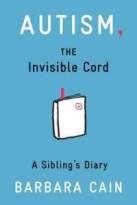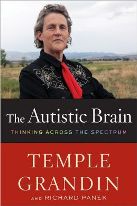2018 School Spending Survey Report
The Autism Spectrum | Books for Kids, Parents, and Teachers
Recent statistics from the CDC reveal that 1 in 88 children have been diagnosed with autism spectrum disorder (ASD). Recent titles for students, teachers, and families, broaden our understanding of individual needs, and highlight the enormous potential for achievement for children and teens on the spectrum.
 For Children and Teens In Barbara Cain’s novel, Autism, The Invisible Cord: A Sibling’s Diary (Magination Press, 2013; Gr 5 Up), 14-year-old Jenny loves her younger brother Ezra and is the first to come to his defense whenever anyone treats him unkindly, but she also knows that living with an autistic sibling has its challenges. Written in first-person diary entries, Jenny’s story takes readers through a school year of ups and downs, both hers and Ezra’s. Along the way, she describes her brother as a toddler, his speech therapy sessions, and tension that develops among family members about his behavior, as well as her own growth as a sister and independent young adult. Chock-full of incidental information about autism, this is an appealing coming-of-age narrative told by a sensitive, self-aware young woman.
For Children and Teens In Barbara Cain’s novel, Autism, The Invisible Cord: A Sibling’s Diary (Magination Press, 2013; Gr 5 Up), 14-year-old Jenny loves her younger brother Ezra and is the first to come to his defense whenever anyone treats him unkindly, but she also knows that living with an autistic sibling has its challenges. Written in first-person diary entries, Jenny’s story takes readers through a school year of ups and downs, both hers and Ezra’s. Along the way, she describes her brother as a toddler, his speech therapy sessions, and tension that develops among family members about his behavior, as well as her own growth as a sister and independent young adult. Chock-full of incidental information about autism, this is an appealing coming-of-age narrative told by a sensitive, self-aware young woman.  “Learning the rules is an important part of school,” writes Blythe Grossberg in Asperger’s Rules: How to Make Sense of School and Friends (Magination Press, 2012; Gr 7 Up). And those rules, many of which are intuitive, are often difficult for young adults with Asperger’s syndrome to decipher. From understanding feelings and emotions to asking teachers for help to handling recess, lunch, and gym, this self-help guide (which might be best utilized with an adult’s help) encourages users to get up close and personal with their responses to everyday situations while developing “SMART” (specific, measurable, attainable, realistic, timely) goals for success. Simple multiple-choice and fill-in-the-blank exercises (for example, “How Well Do You Handle Bullies?”) encourage self-assessment and are paired with advice, conversations for role-playing, and other exercises designed to strengthen social and communication skills.
“Learning the rules is an important part of school,” writes Blythe Grossberg in Asperger’s Rules: How to Make Sense of School and Friends (Magination Press, 2012; Gr 7 Up). And those rules, many of which are intuitive, are often difficult for young adults with Asperger’s syndrome to decipher. From understanding feelings and emotions to asking teachers for help to handling recess, lunch, and gym, this self-help guide (which might be best utilized with an adult’s help) encourages users to get up close and personal with their responses to everyday situations while developing “SMART” (specific, measurable, attainable, realistic, timely) goals for success. Simple multiple-choice and fill-in-the-blank exercises (for example, “How Well Do You Handle Bullies?”) encourage self-assessment and are paired with advice, conversations for role-playing, and other exercises designed to strengthen social and communication skills.  Sy Montgomery profiles an inspiring role model for kids on (and off) the spectrum in Temple Grandin: How the Girl who Loved Cows Embraced Autism and Changed the World (Houghton Harcourt, 2012; Gr 4-8). Born in 1947, Grandin, a professor of animal science, was diagnosed with autism at age three. In short readable chapters, illustrated with photos from the woman’s life and drawings of her inventions, Montgomery tells of Grandin’s struggles in school, her mother’s determination to develop her daughter’s strengths, and her remarkable ability to understand the needs of animals. Facts about autism and Grandin’s work are interspersed. In the foreword and appendix, Grandin extols the virtues of hands-on activities and encourages kids with ASD to get involved in clubs and projects as a way to make friends and explore what they do well, good advice for everyone.
Sy Montgomery profiles an inspiring role model for kids on (and off) the spectrum in Temple Grandin: How the Girl who Loved Cows Embraced Autism and Changed the World (Houghton Harcourt, 2012; Gr 4-8). Born in 1947, Grandin, a professor of animal science, was diagnosed with autism at age three. In short readable chapters, illustrated with photos from the woman’s life and drawings of her inventions, Montgomery tells of Grandin’s struggles in school, her mother’s determination to develop her daughter’s strengths, and her remarkable ability to understand the needs of animals. Facts about autism and Grandin’s work are interspersed. In the foreword and appendix, Grandin extols the virtues of hands-on activities and encourages kids with ASD to get involved in clubs and projects as a way to make friends and explore what they do well, good advice for everyone.  With a kid-friendly format featuring brightly colored text and carton drawings, The Survival Guide for Kids with Autism Spectrum Disorders (And Their Parents) (Free Spirit, 2012; Gr 3 Up) by Elizabeth Verdick and Elizabeth Reeve, both parents of autistic children, is a well-organized, go-to-resource packed with solid information and advice for kids and adults. Divided into three parts, “A Look into Autism Spectrum Disorders,” “Home, School, Community,” and “Body and Brain Basics,” short chapters within each section address a concern or challenge faced by kids with autism. The authors use real-life examples to illustrate particular situations, from talking about ASD to dealing with a noisy school cafeteria to maintaining a healthy diet, and provide realistic tips for success. A list of additional resources is included.
With a kid-friendly format featuring brightly colored text and carton drawings, The Survival Guide for Kids with Autism Spectrum Disorders (And Their Parents) (Free Spirit, 2012; Gr 3 Up) by Elizabeth Verdick and Elizabeth Reeve, both parents of autistic children, is a well-organized, go-to-resource packed with solid information and advice for kids and adults. Divided into three parts, “A Look into Autism Spectrum Disorders,” “Home, School, Community,” and “Body and Brain Basics,” short chapters within each section address a concern or challenge faced by kids with autism. The authors use real-life examples to illustrate particular situations, from talking about ASD to dealing with a noisy school cafeteria to maintaining a healthy diet, and provide realistic tips for success. A list of additional resources is included.  Resources for Adults Temple Grandin, a vocal advocate and designer of humane animal treatment systems, who also happens to be autistic, has recently caught the public’s attention, in part because of an award-winning HBO biopic based on her book Thinking in Pictures (Vintage, 2010). In her latest title, The Autistic Brain: Thinking Across the Spectrum (HMH, 2013), Grandin and co-author Richard Panek look at the science of autism developed by studying functional MRIs of the brain, including Grandin’s, and genetic research. The authors infuse the text with an obvious passion for scientific inquiry, making complex theories and data accessible to general readers. Grandin offers a strong case for increased investigation of sensory problems related to autism and examines the validity and role of self-reporting to aid research. She also urges extreme caution about labeling, which tends to limit individual achievement. She writes, “By cultivating the autistic mind on a brain-by-brain, strength-by-strength basis, we can reconceive autistic teens and adults in jobs and internships not as ‘charity cases’ but as valuable, even essential, contributors to society.”
Resources for Adults Temple Grandin, a vocal advocate and designer of humane animal treatment systems, who also happens to be autistic, has recently caught the public’s attention, in part because of an award-winning HBO biopic based on her book Thinking in Pictures (Vintage, 2010). In her latest title, The Autistic Brain: Thinking Across the Spectrum (HMH, 2013), Grandin and co-author Richard Panek look at the science of autism developed by studying functional MRIs of the brain, including Grandin’s, and genetic research. The authors infuse the text with an obvious passion for scientific inquiry, making complex theories and data accessible to general readers. Grandin offers a strong case for increased investigation of sensory problems related to autism and examines the validity and role of self-reporting to aid research. She also urges extreme caution about labeling, which tends to limit individual achievement. She writes, “By cultivating the autistic mind on a brain-by-brain, strength-by-strength basis, we can reconceive autistic teens and adults in jobs and internships not as ‘charity cases’ but as valuable, even essential, contributors to society.”  Geared to a specific audience, Nancy Mucklow’s Grandparent’s Guide to Autism Spectrum Disorders: Making the Most of the Time at Nana’s House (AAPC, 2012) provides basic introductory information for all adults who care for autistic children. Short chapters explore issues common to autistic children, including sensory and emotional sensitivities, social situations, rules and behavior, communication, and education. Throughout, real-life scenarios describing potentially problematic situations with a child or teen at home or in public are paired with information and suggestions for achieving a positive outcome. Includes lists of useful “Quick Tips” along with fact boxes on topics such as stimming (repeated body movements) and bullying and teasing.
Geared to a specific audience, Nancy Mucklow’s Grandparent’s Guide to Autism Spectrum Disorders: Making the Most of the Time at Nana’s House (AAPC, 2012) provides basic introductory information for all adults who care for autistic children. Short chapters explore issues common to autistic children, including sensory and emotional sensitivities, social situations, rules and behavior, communication, and education. Throughout, real-life scenarios describing potentially problematic situations with a child or teen at home or in public are paired with information and suggestions for achieving a positive outcome. Includes lists of useful “Quick Tips” along with fact boxes on topics such as stimming (repeated body movements) and bullying and teasing.  In Parenting Girls on the Autism Spectrum: Overcoming the Challenges and Celebrating the Gifts (Jessica Kingsley, 2012), Eileen Riley-Hall, the mother of 14-year-old Lizzie who has Asperger’s and younger daughter Caroline who is autistic, chronicles her personal journey through the spectrum. Riley-Hall offers practical advice for parents raising autistic children and teens while highlighting the special situations girls face when dealing with social expectations. Writing in the voice of a trusted friend but always clear to distinguish between her opinion and other information, the author discusses diagnosis and acceptance, educational options and interventions, truths and myths about autism, and her own triumphs and mistakes with a generous dose of good humor. Myriad informational websites are included.
In Parenting Girls on the Autism Spectrum: Overcoming the Challenges and Celebrating the Gifts (Jessica Kingsley, 2012), Eileen Riley-Hall, the mother of 14-year-old Lizzie who has Asperger’s and younger daughter Caroline who is autistic, chronicles her personal journey through the spectrum. Riley-Hall offers practical advice for parents raising autistic children and teens while highlighting the special situations girls face when dealing with social expectations. Writing in the voice of a trusted friend but always clear to distinguish between her opinion and other information, the author discusses diagnosis and acceptance, educational options and interventions, truths and myths about autism, and her own triumphs and mistakes with a generous dose of good humor. Myriad informational websites are included. RELATED
RECOMMENDED
CAREERS
The job outlook in 2030: Librarians will be in demand
CAREERS
The job outlook in 2030: Librarians will be in demand
ALREADY A SUBSCRIBER? LOG IN
We are currently offering this content for free. Sign up now to activate your personal profile, where you can save articles for future viewing






Add Comment :-
Be the first reader to comment.
Comment Policy:
Comment should not be empty !!!